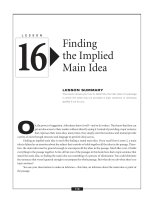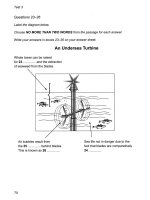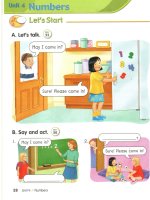Finding main idea 2 potx
Bạn đang xem bản rút gọn của tài liệu. Xem và tải ngay bản đầy đủ của tài liệu tại đây (84.55 KB, 6 trang )
Practice 1
Try these questions on the following statements. Read
them carefully, and then write F in the blank if the
statement is a fact and O if it is an opinion. The answers
appear right after the questions.
1. The Academy Awards honor the film
industry.
2. The Academy Awards are always fun to
watch.
3. More independent films should win
Academy Awards.
4. The Academy Awards are an annual
event.
5. Best director is the most interesting
Academy Award category.
Answers
1. Fact
2. Opinion
3. Opinion
4. Fact
5. Opinion
Practice 2
Now try the same exercise with a complete paragraph.
U
nd
erline the facts and use a highlighter or colored pen
to highlight the opinions. Be careful—you may find
fact and opinion together in the same sentence. When
you’ve finished, you can check your answers against the
marked passage that follows.
– THE DIFFERENCE BETWEEN FACT AND OPINION–
41
There are many different ways to invest your money to provide for a financially
secure future. Many people invest in stocks and bonds, but I think good old-
fashioned savings accounts and CDs (certificates of deposit) are the best way to
invest your hard-earned money. Stocks and bonds are often risky, and it doesn’t
make sense to risk losing the money you’ve worked so hard for. True, regular sav-
ings accounts and CDs can’t make you a millionaire overnight or provide the high
returns some stock investments do. But by the same token, savings accounts and
CDs are fully insured and provide steady, secure interest on your money. That
makes a whole lot of cents.
Answers
How did you do? Was it easy to distinguish between the facts and the opinions? Here’s what your marked-up pas-
sage should look like. The facts are underlined and the opinions are in boldface type.
– THE DIFFERENCE BETWEEN FACT AND OPINION–
42
Ther
e are many differ
ent ways to invest your mo
ney to provide f
or a financial
ly
secure fu
ture.M
any people invest in sto
cks and bonds, but I think good old-
fashioned savings accounts and CDs (certificates of deposit) are the best way
to invest your hard-earned money. St
oc
ks and bonds are oft
en risky, and it
doesn’t make sense to risk losing the money you’ve worked so hard for. T
rue,
regular sa
vings acc
ounts and CDs can’t make you a millionaire o
vernight or
pro
vide the high re
turns some stock inv
estments do. But by the same token,
sa
vings accounts and CDs are fully insured and provide steady, secure interest
on y
our mone
y. That makes a whole lot of cents.
Practice 3
To strengthen your ability to distinguish between fact
and opinion, try this. Take a fact, such as:
FACT: Wednesday is the fourth day of the week.
Now, turn it into an opinion. Make it something
debatable, like this:
OPINION: Wednesday is the longest day of the week.
Here’s another example.
FACT: You must be 18 years old to vote in the United
States.
OPINION: The voting age should be lowered to 16 years
of age.
Now you try. Suggested answers come after the
questions.
6. FACT: Healthcare costs have risen over the last
several years.
OPINION:
7. FACT: The 22nd Amendment of the United States
Constitution establishes a two-term limit
for the presidency.
OPINION:
8. FACT: More than 58,000 Americans lost their lives
in the Vietnam War.
OPINION:
9. FACT: The Motion Picture Association R
(Restricted) rating requires anyone under
17 to be accompanied by a parent or adult
guardian.
OPINION:
10. FACT: Use of performance-enhancing drugs is
strictly prohibited in both amateur and
professional sports.
OPINION:
Answers
There are, of course, many opinions you could form
from these subjects. Here are some possible answers.
6. Our government should make healthcare a higher
priority.
Companies should give employees several health-
care programs from which to choose.
People should stop complaining about health-
care costs.
7. Presidents should be allowed to serve for three
terms.
Limiting service to two terms will make U.S. pres-
idents more effective.
Term limits are a very bad idea.
8. American soldiers should not have been sent to
Vietnam.
Our government did all the right things concern-
ing the Vietnam War.
9. The Motion Picture Association should not be
able to rate films.
The Motion Picture Association ratings should
be taken seriously by all parents.
Movie ratings are useless.
10. Performance-enhancing drugs should be legal.
Competitive sports would be more interesting to
watch if performance-enhancing drugs were legal.
Performance-enhancing drugs are the worst thing
that ever happened to competitive sports.
Summary
The ability to differentiate between fact and opinion is
a very important skill. Like a detective, you need to
know the difference between what people think and
what people know, between what people believe to be
true and what has been proven to be true. Then you will
be able to see whether writers support their opinions,
and if they do, how they do it. This will allow you to
judge for yourself the validity of those opinions.
– THE DIFFERENCE BETWEEN FACT AND OPINION–
43
■
Listen carefully to what people say today and try to determine whether they are stating a fact or express-
ing an opinion. When they offer opinions, do they support them?
■
As you come across facts and opinions today, practice turning them into their opposites; make facts
out of opinions and opinions out of facts.
Skill Building until Next Time
n order to solve a crime, a detective cannot just get the facts of the case, just discover the motive, just deci-
pher difficult clues, or just distinguish between fact and opinion. To be successful, a detective must do all
these things at the same time. Similarly, reading really can’t be broken down into these separate tasks. Read-
ing comprehension comes from employing all these strategies simultaneously. This lesson gives you the oppor-
tunity to combine these strategies and take your reading comprehension skills to the next level.
LESSON
Putting It All
Together
LESSON SUMMARY
This lesson reviews what you learned in Lessons 1–4: getting the
facts, finding the main idea, determining what words mean in context,
and distinguishing between fact and opinion. In this lesson, you’ll get
vital practice in using all four skills at once.
5
45
Review: What You’ve
Learned so Far
These are the strategies you studied in the past four
lessons:
■
Lesson 1: Find the facts in what you read. Yo u
practiced looking for the basic information that
was being conveyed in the paragraphs: the who,
what, when, where, and how.
■
Lesson 2: Find the main idea. You learned about
topic sentences and how they express an assertion
about the subject of the paragraph. You saw how
the main idea must be general enough to encom-
pass all other sentences in the paragraph; it is the
thought that controls the paragraph, and the other
sentences work to support that main idea.
■
Lesson 3: Determine the meaning of words from
context. You practiced looking for clues to
determine meaning in the words and sentences
surrounding the unfamiliar word or phrase.
■
Lesson 4: Distinguish between fact and opinion.
You learned that a fact is something known to be
true, whereas an opinion is something believed to
be true. You practiced distinguishing between the
two and saw how good paragraphs use facts to
support opinions.
Practice
In this lesson, you will sharpen your reading compre-
hension skills by using all of these strategies at once.
This will become more natural to you as your reading
skills develop.
Practice Passage 1
Begin by looking at the following paragraph. Remem-
ber to read actively; mark up the text as you go. Then
answer the questions on the next page. An example of
how to mark up the passage, as well as the answers to
the questions, follow.
If any of these terms or strategies sound
unfamiliar to you, STOP. Take a few minutes
to review whatever lesson is unclear.
– PUTTING IT ALL TOGETHER–
46
It is clear that the United States is a nation that needs to eat healthier and slim
down. One of the most important steps in the right direction would be for school
cafeterias to provide healthy, low-fat options for students. In every town and city,
an abundance of fast-food restaurants lure teenage customers with fast, inex-
pensive, and tasty food, but these foods are typically unhealthy. Unfortunately,
school cafeterias—in an effort to provide food that is appetizing to young
people—mimic fast food menus, often serving items such as burgers and fries,
pizza, hot dogs, and fried chicken. While these foods do provide some nutritional
value, they are relatively high in fat. Many of the lunch selections school cafete-
rias currently offer could be made healthier with a few simple and inexpensive
substitutions. Veggie burgers, for example, offered alongside beef burgers, would
be a positive addition. A salad bar would also serve the purpose of providing a
healthy and satisfying meal. And tasty grilled chicken sandwiches would be a far
better option than fried chicken. Additionally, the beverage case should be
stocked with containers of low-fat milk.









